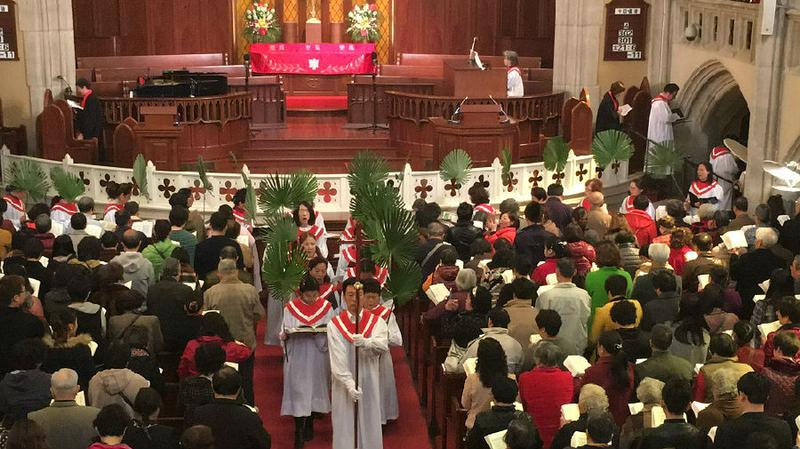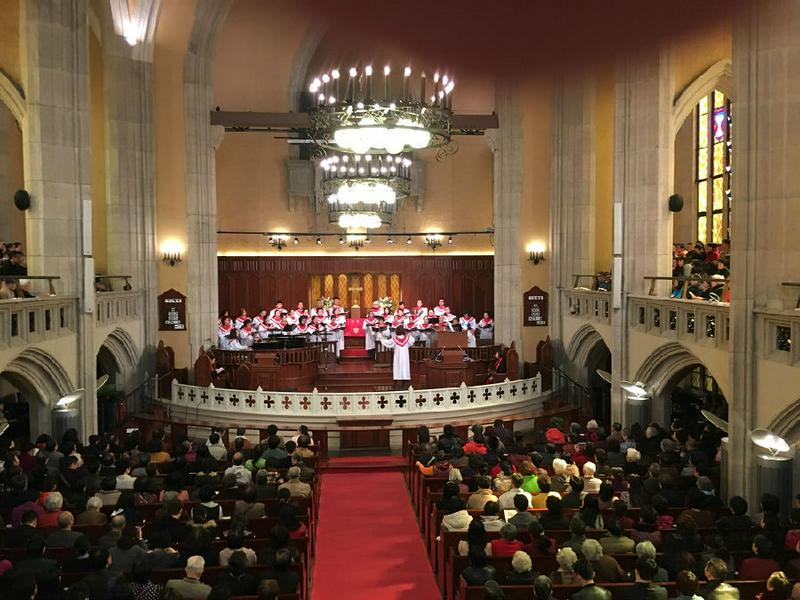Palm Sunday is the Sunday before Easter Sunday 2016. Melodious Praise heard in the 140-year-old Moore Memorial Church, Shanghai.
The climax of this Sunday Service is that the congregation hold a palm branch, meditating on Christ's triumphal entry into Jerusalem.
At the beginning of the service, the congregation sing the holy song: Praise the Father. The choir forward slowly from the ground to the altar, with the leader cocking up a Cross and each of the choir member holding a palm branch.
After that the host said a leading prayer for the service. “Today we recalled the day you took your bitter road. We meditate on the great sacrifice you suffered for us. ”
Every and each of the word in the host’s prayer falls in the heart of the congregation. Many of them response the prayer with “Amen.”
The classical and familiar praise song What a friend we have in Jesus turned on today’s sermon. The pastor recited Bible verses recording Christ’s triumphal entry into Jerusalem, delivering the message of “What a lord Jesus is.”
Brief history of Moore Memorial Church(MMC) Shanghai
MMC was built in 1887 and named Central Methodist Church. It was refurbished with a large gift from Mr. and Mrs. Lyman Royster Moore of Kansas City, and renamed Moore Memorial Church, in 1900. In 1925, it was moved to its current location on Tibet Street and rebuilt with funds raised both locally and from overseas. From the beginning, MMC was “totally foreign run.” It also had a strong connection with the Nationalist government, with some of its leaders being close friends of the powerful Soong family and then of Chiang Kai-shek and Madame Chiang, with both sides deriving benefits from this cozy relationship. That does not mean, however, that the church’s clergy always approved of, or expressed support for, what the KMT government did.

The new building soon “became a focal point for the Methodist movement in China,” assuming an importance it still retains. Topped by a tall neon cross, the structure represented all that was modern and Western in booming Shanghai, and attracted large numbers of people who were open to new ideas and interested in Christianity. Many became sincere followers of Christ.
An “institutional church” was defined in 1908 by Edward Judson as “an organised body of Christian believers, who, finding themselves in a hard and uncongenial social environment, supplement the ordinary methods of the gospel – such as preaching, prayer meetings, Sunday School, and pastoral visitation – by a system of organised kindness, a congeries of institutions, which, by touching people on physical, social and intellectual sides, will conciliate them and draw them within reach of the gospel.”. MMC was founded as such an institution, in direct contrast to fundamentalists who concentrated upon preaching the gospel and Christian worship and prayer meetings. There was “ a kindergarten, a nursery school, primary school, health clinics, language classes, occasional lectures, a reading room, kitchens, community organizations and many activities for students and young working people,” including a shoe-shine cooperative that taught boys how to make a living for themselves.

One group, called “the naughty and nice girls,” began as a class on finance and home management, but expanded into its own community center, with a “day school that eventually catered for up to 230 children, an evening school for men and women, a weekly skin and eye clinic, a sewing group and a Sunday school. They also had a small plot of ground in which they grew corn and vegetables to help feed visitors.”
When the Japanese began their vicious assault on China, MMC served as a haven for refugees and a base for caring for those impacted by the war. The Japanese occupied the building as soon as they marched into Shanghai soon after the attack on Pearl Harbor in 1941, hoisting their flag above the cross, though eventually on a separate flag pole. Foreign funds were cut off, leaving the congregation hard pressed to continue the extensive social programs which had been part of the core of its ministry in the city. Later, missionaries were interned, and all humanitarian work ceased. Previous connections with foreigners were a great liability during this time.
After the war, the missionaries returned and the church was repaired with the help of foreign funds. With the outbreak of the civil war, humanitarian aid once more came to the fore of MMC ministries. When the Communists gained control of China, however, all foreign missionaries were soon expelled, and connections with these foreigners, who were labeled “imperialists” at best and “spies” at worst, became a huge liability for all Chinese who had worked with them. They were accused of being accomplices with the missionaries in their part in Western domination of China.
To protect themselves, many Chinese Christian leaders, including some at MMC, joined in the general accusations against their former foreign colleagues; others kept silent. Some of the denunciations were hard to understand, given the previous close relationships which had existed. Under the leadership of Wu Yaozong and others, the Three Self Patriotic Movement was formed, with the explicit goal of eradicating all foreign influence on Chinese Christianity.
Translated by: Eliana











